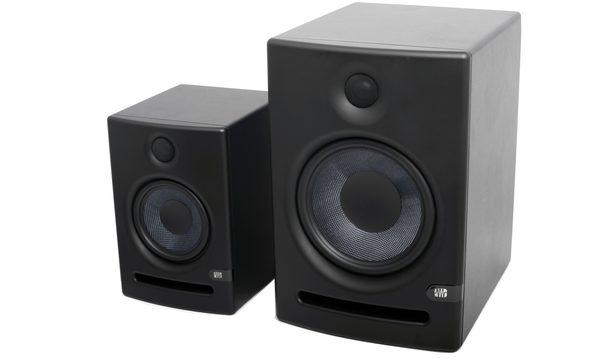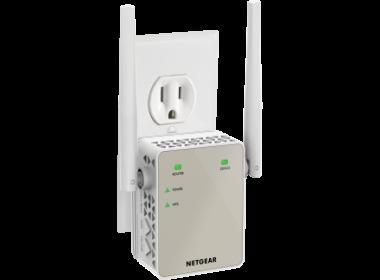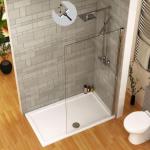The American company Presonus maintains a small, fine portfolio of high-quality audio solutions for the home studio. The monitor controller central station and monitor station have long been part of the standards in the project studio - only studio loudspeakers were missing in the offer up to now. And since the market for near-field monitors is already fiercely competitive, you have to come up with something as a shooting star. Or "just be better" than the others, which specifically means: high quality, many features, AND low price. What could be more obvious than to have these speakers come to us and test them extensively
PreSonus Eris E5 and Eris E8 Details
The Presonus Eris 5 and Eris 8 are active 2-way nearfield monitors in the budget price range and are traded in pairs, which is quite common. With the 5.25-inch woofer, the Eris 5 is the best studio monitor for under 300 dollars, while the Eris 8 with the 8-inch speaker is extremely lavishly equipped. The bass drivers are made of Kevlar fabric, which is now "good form" in this league. Here they have been colored "blue" for a change. In the studio dim light, however, they look almost black. Due to the very similar components, the Presonus box is similar to several other monitor boxes, including the M-Audio BX8 D2 and BX5a, the ESI Unik 05, and the Behringer B1030A.
Active means that the crossover is in front of the built-in output stages and uses "active" components, such as operational amplifiers, to separate the frequency spectrum. Separation takes place at 3 kHz (Eris 5) and 2.2 kHz (Eris 8). As a result, two power amplifiers ("bi-amping") are used per speaker, which supplies the tweeters and woofers independently of one another. It is good to know that you can achieve fairly linear results with this principle and relatively little (financial) effort.
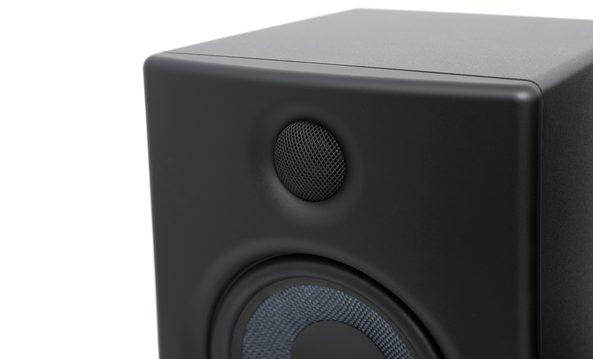
As you can already see from our lead picture, the two models differ significantly in their dimensions. While the small Eris 5 can still be placed on the desk in combination with optional foam wedges, the large Eris 8, on the other hand, gets tighter! In any case, tripods shouldn't just be an optional extra, they should be a must. For detailed dimensions and weight, please refer to the following list:
- Model: Eris 5 / Eris 8
- Width in mm: 178/250
- Depth in mm: 195/299
- Height in mm: 260/384
- Weight in kg: 4.6 / 10.1
The 1.25-inch silk dome tweeter of the Eris 8 receives 65 “watts” according to the datasheet, while the 1-inch tweeter of the Eris 5 receives 35 watts. The bass drivers are powered by 45 watts (Eris 5) or 75 watts (Eris 8). It should be clear that this cannot be RMS information and should come as no surprise in this price segment.
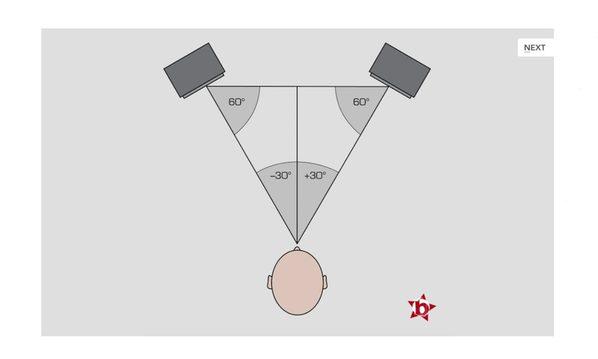
The situation is similar to the following information, which remains "relatively unrelated" without further references and should not be blindly trusted when comparing boxes. However, this is not just a problem for Presonus, but rather due to our “dull trust” in numbers. Nevertheless, I do not want to withhold these values: The transmission curve for the large Eris 8 is specified at 35 Hz to 22 kHz, and that for the smaller Eris 5 with 53 Hz to 22 kHz. The "considerable" values are missing at the reference point of the corner frequencies (eg "-3dB"). It is strange that in an older press release the lowest corner frequencies were still about 10 Hz higher.
Also read about: Shower bath a modern bathing luxury in your washroom
The bass driver and the bass port of the Eris 8. The logo lights up blue when active
It is basically the same with the specified maximum sound pressure level, which is why it should only be mentioned without comment at this point: 102 dB "Peak SPL" for Eris 5 and 105 dB "Peak SPL" for the Eris 8 and that at a distance of one meter Like almost all loudspeakers today, the robust bass reflex housing is made of MDF and has been foiled with matt black vinyl. The front baffle is made of straightforward plastic, has no edges, and is slightly curved outwards, which is intended to reduce edge reflections and flow noise. The baffle is also curved around the tweeter and even acts as a waveguide here to couple it more homogeneously to the baffle. The bass port is in the form of a wide slot at the bottom, which means that the speaker can also be set up close to the wall if necessary. Although one could expect otherwise from “Manufactured in China”, none of my four samples showed any defects or irregularities in the workmanship. The speakers appear very solid and of high quality.
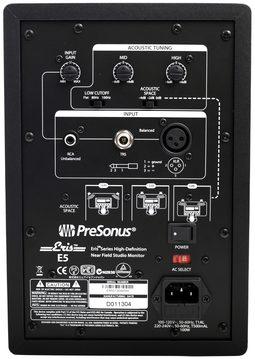
All connections are of course on the back: There is an IEC "cold device connection" for 120/240 volts, the voltage selector switch, the main switch as well as the audio inputs, and an extensive filter section. The connection section also leaves nothing to be desired: symmetrical XLR and 1/4-inch TRS ("large jack") connection (+ 4dBu) as well as unbalanced cinch at -10dBV level. What more do you want.
There is also an INPUT-GAIN potentiometer with a rastered “Unity” center position. The other two steps potentiometers are also provided with a rasterized middle position, but are used to adjust the sound and represent a +/- 6 dB peak middle filter at 1 kHz (MID) and a +/- 6 dB treble shelving filter from 10 kHz (HIGH).
The bass filters, on the other hand, come in the form of two small slide switches: LOW CUTOFF is to be seen as a classic high-pass, which cuts the box "down" and the positions "Off (Flat)" / "80 Hz" / "100 Hz" knows. At this point, one should not hide the fact that a “subsonic filter” is installed, which basically filters out “very deep” tones anyway. ACOUSTIC SPACE, on the other hand, is a wide shelving filter that starts below 800 Hz and is intended to compensate for positioning in the corner (quarter space), in front of the wall (half space), or the room (full space). This allows you to lower the bass again by 0 dB / -2 dB / -4 dB. All that's missing is a desktop filter, but we don't want to be cocky. It continues with the practice!
